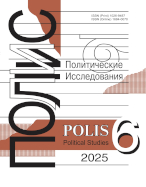A view from China on Soviet aid during World War II:
the case of the 88th rifle brigade of the Far Eastern front
Zuenko I.Yu.,
MGIMO University, Moscow, Russia, i.zuenko@inno.mgimo.ru
elibrary_id: 802840 | ORCID: 0000-0002-9853-9703 | RESEARCHER_ID: AAB-5070-2020
Article received: 2025.02.11 20:49. Accepted: 2025.03.12 20:49

DOI: 10.17976/jpps/2025.04.13
EDN: LHERCI
Zuenko I.Yu. A view from China on Soviet aid during World War II: the case of the 88th rifle brigade of the Far Eastern front. – Polis. Political Studies. 2025. No. 4. https://doi.org/10.17976/jpps/2025.04.13. EDN: LHERCI (In Russ.)
The article was prepared within the framework of a research project under the grant of the Russian Science Foundation No. 23-18-00109.
The article examines the perception in China of cooperation with the Soviet Union during World War II (including the defeat of the Japanese Kwantung Army and the liberation of Manchuria in August-September 1945) in the context of the policy of historical memory (as understood by Assmann and Halbwachs). As a case for examining the historical memory of these events taking shape in China, the reflection in Chinese sources of the history of the 88th Separate Rifle Brigade of the Far Eastern Front is used – a Soviet military unit in which there were Chinese and Korean partisans forced to retreat to the territory of the USSR from Japanese-occupied Manchuria. The author shows that due to Beijing’s desire to emphasize its own efforts to liberate China, contradictions arise in the assessment of the history of this unit in the two countries. A direct manifestation of these contradictions was the delay in the opening of a memorial complex in honor of the 88th Brigade in the Vyatskoye village (Khabarovsk Krai), due to the Chinese side using formulations that contradict the Russian position. The author comes to the conclusion that the peculiarities of the development of nationalist sentiments in modern China and the policy of historical memory about the contribution of the PRC to the victory of the Allies significantly alter, if not limit, the prospects for using the memory of the history of Soviet aid in the 1940s to strengthen relations between the two countries.
References
Mitter, R. (2013). Forgotten ally: China’s World War II, 1937-1945. Boston: Houghton Mifflin Harcourt.
Nye, J. (1990). Soft power. Foreign Policy, 80, 153-171. https://doi.org/10.2307/1148580
Zuenko, I.Yu. (2024). Between cooperation and alarmism: problems of common history interpretation in Russia and China. Russia in Global Affairs, 22(4), 155-172. https://doi.org/10.31278/1810-6374-2024-22-4-155-170.
Assmann, A. (2014). Der lange Schatten der Vergangenheit. (Russ. ed.: Assmann. A. Dlinnaya ten’ proshlogo: Memorial’naya kul’tura I istoricheskaya politika. Moscow: New Literary Observer. 328 p.)
Denisov, I.E., & Zuenko, I.Yu. (2022). New approaches of Beijing to the historiography of People’s Republic of China and Communist party of China: ‘rectification of names’ during Xi Jinping era. Oriental Studies, 5(4), 734-750. (In Russ.) https://doi.org/10.31696/2618-7043-2022-5-4-734-750
Halbwachs, M. (2007). Les Cadres sociaux de la mémoire. (Russ. ed.: Halbwachs M. Sotsial’nye ramki pamyati. Moscow: Novoe Izdatel’stvo).
Ivanov, V.I. (2009). V tylakh Kvantunskoy armii [In the rear of the Kwantung army]. Moscow: IDV RAN. (In Russ.)
Kondrashova, L.I., & Chubarov, I.G. (2023). CPC central committee resolution on party history and political-economic coordinates of China development. Russian Sinology, 4, 190-204. (In Russ.). https://doi.org/10.48647/ICCA.2024.61.44.007
Konstantinov, G.D. (2015). Osobaya internatsional’naya: 88 otdelnaya strelkovaya brigada Dal’nevostochnogo fronta [Special International: The 88th Separate Rifle Brigade of the Far Eastern front]. Khabarovsk: Priamurskiye vedomosti]. (In Russ.)
Li, Yanling, & Tavrovsky, Yu.V. (Eds.). (2020). 75 Let Velikoy Pobedy. Bor’ba sovetskogo i kitayskogo narodov protiv yaponskogo militarizma [75 years of the Great Victory: the struggle of the Soviet and Chinese peoples against Japanese militarism]. Harbin; Vladivostok: VGUES. (In Russ.)
Muratshina, K.G. (2015). Russian-Chinese relations and China’s position on the second world war, on the USSR’s great patriotic war, and on China’s anti-Japanese war. Izvestiya Ural Federal University. Series 3: Social Sciences, 1, 112-127. (In Russ.)
Nin, Yanhun, & Gao, Yan. (2023). The Role of the Personnel of the 88th Separate Rifle Brigade During the War Against the Japanese Invaders. Problems of the Far East, 2, 147-161. (In Russ.)
Miller, A.I., & Solovyev, A.V. (Ed.). (2022). Pamyat’ o Vtoroy mirovoy voyne za predelami Yevropy [Memory of World War II Beyond Europe]. St. Petersburg. EUSP Press. (In Russ.)
Verchenko A.L. (2020). The 88th Brigade and Soviet-Chinese cooperation: unity of goals and a common victory. Modern Oriental Studies, 2(5), 62-75. (In Russ.)
Wang, Qi, Kulik, S.V., & Smirnova D. (2017). On the issue of Chinese historiography of World War II. Terra Linguistica, 8(1), 35-47. (In Russ.) https://doi.org/10.18721/JHSS.8104
Zuenko, I.Yu. (2023). Museums and memorial sites in the Russian-Chinese borderlands: prospects for creating a “compromise” version of shared history. Comparative Politics, 14(3), 24-40. (In Russ.) https://doi.org/10.46272/2221-3279-2023-3-14-23-38
Zuenko, I.Yu. (2024). Kitai v epokhu Si Tszin’pina [China in the age of Xi Jinping]. Moscow: AST. (In Russ.)
Peng, Xunhou (Ed.). (2015). Friendship: authentic records of China and the Soviet Union’s joint struggle against the fascists. Beijing: Wuzhou Chuanbo Chubanshe. (In Chin.)
Gao, Xiaoting. (2018). A study on the formation of the Training Brigade of the Northeast Anti-Japanese United Army and its historical role. Shenyang Normal University. (In Chin.)
Li, Tao. (2019). The Training Brigade of the Northeast Anti-Japanese United Army and the Soviet Far Eastern campaign. Military History, 6, 48-52. (In Chin.)
Peng, Shilu. (2006). History of the establishment of the Training Brigade of the Northeast Anti-Japanese United Army. CCP History Materials, 2, 109-125. (In Chin.)
Sun, Chengwu. (1994). The Training Brigade of the Northeast Anti-Japanese United Army – the 88th Brigade. Heilongjiang History, 1, 26-29. (In Chin.)
Zhang, Hongping, & Zhuang, Shanjie. (2016). Analysis of the Background of the Establishment of the Training Brigade of the Northeast Anti-Japanese United Army. Lantai World, 8, 74-75. (In Chin.) https://doi.org/10.16565/j.cnki.1006-7744.2016.08.29
See also:
Korotetskaya L.V.,
Particular features of the intellectual patriotic discourse in Germany of the 1990s. – Polis. Political Studies. 2012. No1
Voskressenski A.D.,
Type of socio-political access within a society and the space of the world politics (historical evolution of the world system). – Polis. Political Studies. 2013. No2
Yevzerov R.Ya. ,
World War as the 20th Century Phenomenon. – Polis. Political Studies. 1995. No3
Chugrov S.V.,
Rethinking the Results of World War II in Contemporary Japan. – Polis. Political Studies. 2020. No5
Zarubina N.N., Noskova A.V.,
Images of Russia: Reflecting on the Eras of Change. – Polis. Political Studies. 2019. No2




.jpg)






 print
print.jpg)
.jpg)
